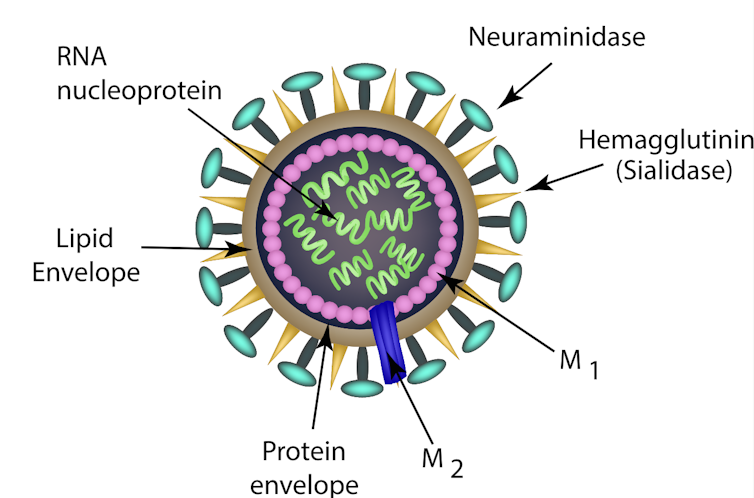Paul Griffin, The University of Queensland
After having low rates of influenza (flu) transmission in recent years, thanks to our COVID control strategies, case numbers are now rising.
So far this year, Australia has had more than 32,000 lab-confirmed cases of the flu and 32 deaths.
Getting a flu vaccine is the best way to protect against getting the flu. These are reformulated each year to protect against the most widely circulating strains – if our predictions are right.
Below you’ll find everything you need to know about the 2023 flu vaccine. But first, some flu basics.
What are the different types of flu?
There are two main types of influenza: influenza A and influenza B. On the surface of the influenza virus there are two main proteins, the hemagglutinin (HA or H) and neuraminidase (NA or N).
Different strains are named after their versions of the H and N proteins, as in H1N1 or “’swine flu’.

Minor changes in the proteins (HA and NA) on the surface are common because the enzyme the virus uses to make copies of itself is prone to errors.
Sometimes the influenza virus can change more abruptly when it mixes up components from different influenza viruses – including influenza viruses that typically infect birds, pigs or bats – to create a virus that’s basically new.
The regular change in the virus is the reason the vaccine is updated every year. The Australian Influenza Vaccine Committee meets late in the year to plan what should be included in the vaccine for the following season, after considering what happened in our last flu season and in the Northern Hemisphere winter.
What strains does this year’s flu shot protect against?
Modern flu vaccines typically protect against four strains. For this year’s vaccine, the committee has recommended it includes:
- an A/Sydney/5/2021 (H1N1)pdm09-like virus
- an A/Darwin/9/2021 (H3N2)-like virus
- a B/Austria/1359417/2021 (B/Victoria lineage)-like virus
- a B/Phuket/3073/2013 (B/Yamagata lineage)-like virus.
The naming of the viral components can sometimes be confusing. The name is derived from the virus type (A or B)/the place it was first isolated/strain number/year isolated (virus subtype).
This year’s vaccine therefore includes an influenza A virus similar to the 2009 pandemic-causing H1N1 isolated from Sydney in 2021 and a second influenza A virus (H3N2) isolated in Darwin in 2021.
Influenza B viruses are classified into 2 lineages: Victoria and Yamagata. This year’s vaccine includes an influenza B isolated from Austria in 2021 (Victoria lineage) and an influenza B isolated in Phuket in 2013 (Yamagata lineage).

Who should get a flu shot?
Health authorities recommend everyone aged six months of age or over should get the flu vaccine every year.
Some groups are at greater risk of significant disease from the flu and can access the flu vaccine for free. This includes:
- Aboriginal and Torres Strait Islander people aged six months and over
- children aged six months to five years
- pregnant women at any stage of pregnancy
- people aged 65 years or over
- people aged five years to 65 years who have certain underlying health conditions affecting the heart, lungs, kidneys or immune system, and those with diabetes.
How can I get it?
You can get a flu shot from your local general practice or pharmacy. Or you may have an opportunity to get vaccinated at your workplace if your employer supplies it.
While the vaccine is free for those in the above groups, there can be a consultation or administration fee, depending on where you get your vaccine.
If you aren’t eligible for a free vaccine, it usually costs around $20-$30.
 Some people can get the shot for free, while others pay $20 to $30. Shutterstock
Some people can get the shot for free, while others pay $20 to $30. ShutterstockAre there different options?
For over 65s, whose immune systems may not work as well as when they were younger, a specific vaccine is available that includes an adjuvant which boosts the immune response. This is free for over-65s under the national immunisation program.
A high-dose vaccine is also available for people aged 60 and over. However this isn’t currently funded and costs around $70 on a private prescription.
People with egg allergies can safely get the egg-based flu vaccine. However, there is also a cell-based immunisation for people who don’t want a vaccine made in eggs. When vaccines are grown in eggs, sometimes the virus can change and this might affect the level of protection. Cell-based vaccines aim to address this issue.
The cell-based vaccine isn’t funded so patients will pay around $40 for a private prescription.
How well do they work?
The vaccine’s effectiveness depends on how well the strains in the vaccine match those circulating. It generally reduces the chance of being admitted to hospital with influenza by 30-60 per cent.
What are the side-effects?
You can’t get the flu from the vaccine as there’s no live virus in it.
When people get a flu-like illness after the vaccine, it can be due to mild effects we sometimes see after vaccination, such as headaches, tiredness or some aches and pains. These usually go away within a day or two.
Alternatively, symptoms after getting a flu shot may be due to another respiratory virus such as respiratory syncytial virus (RSV) that circulates in winter.
When’s the best time to get your flu shot?
The vaccine provides peak protection around three to four months after you get it.
The peak of the flu season is usually between June and September, however this changes every year and can vary in different parts of the country.
Given this, the best time to get the vaccine is usually around late April or early May. So if you haven’t already, now would be a good time to get it.![]()
Paul Griffin, Associate Professor, Infectious Diseases and Microbiology, The University of Queensland
Do you get the flu shot every year? Why or why not? Why not share your experience in the comments section below?
Also read: Could internet surfing stave off dementia?
This article is republished from The Conversation under a Creative Commons licence. Read the original article.


I recently had the flu jab at my local pharmacy. After getting home and seeing the receipt, I saw that I had received the ‘so called weaker’ chargeable jab for the under 65s. I phoned the pharmacist angry that I had received the weaker jab and why not the stronger one for the 65+?
He said the jab given for free to the over 65s is in fact inferior and weaker because it it only cover three and not four viruses, not the latest, important one. He said it’s free because the jab covering the latest flu virus is more expensive so it’s not free. He said I know you wiuld want the best ptotection. The free one is only increased in strength for the old viruses, to last a bit longer.
So if you want the better flu protection it might be worth paying for it